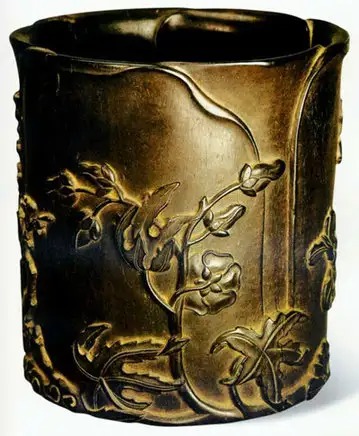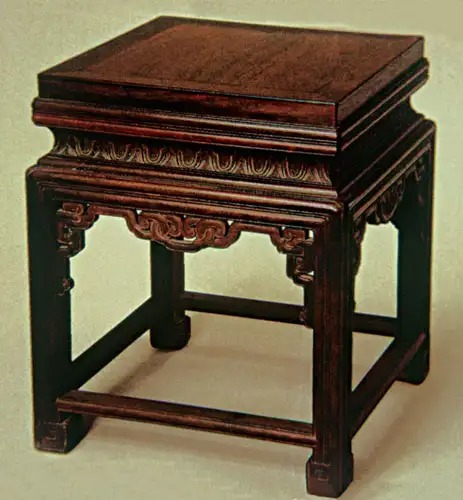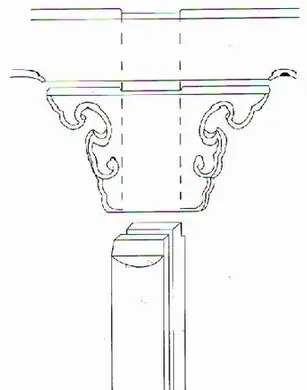Oriental furniture
Searching for Rosewood
The Chinese people's feelings towards wood are reflected very specifically in their furniture. They all like wood with special properties. For example, they will use a kind of wood called eagle tea tree to make cupboards, because this wood can prevent food from going bad; they will use cypress to make coffins, because this wood is not easy to rot when buried underground; they will use sandalwood to make axe handles, because this wood is not easy to deform, thus ensuring better safety.

Rosewood Pen Holder
This is the red sandalwood, which is known as the king of wood. Red sandalwood grows very slowly. According to folk saying, it takes a hundred years for this wood to grow one inch, and five inches to become a timber, which means it has to grow for five hundred years. As the wood grows bigger, it is more likely to be hollow, so only one percent of it can be used. This is how the saying "an inch of red sandalwood is worth an inch of gold" came about. According to Chinese tradition, if it is a good thing that is not easy to get, it will be upgraded to be used exclusively by the royal family. Therefore, during certain years of the Qing Dynasty, only the Forbidden City, the Summer Palace, Beihai and other royal gardens in Beijing could use red sandalwood, and it was forbidden for the public to use it.
There are several reasons why red sandalwood is so good. First, it contains a lot of oil, so the finished product will not break. Second, the pattern of real red sandalwood is naturally beautiful and does not need to be painted or colored. Third, it is hard and has very fine fibers. Its bonding strength is much stronger than that of ordinary wood. Therefore, it is most suitable for exquisitely carved dragons and phoenixes. After forming, it only needs to be polished and waxed to produce a brocade-like color. Because it is precious, it receives special treatment in the "material preparation" stage. First, it must go through repeated micro-baking and air-drying for up to ten years until its oil is forced out. Therefore, as long as a family has a red sandalwood utensil, it will be a family heirloom. The emperor likes it, and the people follow suit. The royal family fought hard to conquer it, and the people also secretly mined it, so that red sandalwood was hard to find in the late Qing Dynasty in China, and it could only be found abroad.

Rosewood furniture
Red sandalwood can only live in the memory of the Chinese people. Fortunately, a 25,000-square-meter red sandalwood museum was built in Beijing in the late 20th century. Here, you can not only appreciate the Ming and Qing furniture that took a lot of time to collect, but also appreciate the display of traditional furniture materials, shapes, and structures. Of course, you can also see various Buddhist cultural artworks, round sculptures, reliefs, openwork carvings and other carving techniques, 320 dragons with different postures, miniature corner towers of the Forbidden City, Qianqiu Pavilion and Wanchun Pavilion in the Forbidden City Imperial Garden, and other ancient Chinese architectural landscapes.
Textures and finishes
Chinese people like things with natural colors. Of course, this mainly refers to the taste of scholars. This color not only includes the original color and texture of wood, but also the smell of wood itself. This pursuit, which can almost be regarded as the collective aesthetic taste of Chinese people, has evolved step by step. The so-called extreme splendor returns to plainness, which is a spiritual return of a nation and its culture after being accustomed to complicated and redundant decorations. However, this return is sometimes not a gradual development. Instead, after a dynasty has prospered for a long time, with thousands of patterns and splendors, the noise is removed, and the people are enriched. The stimulation from the outside world may slowly turn to retreat to the heart. If it collapses in one day, everything will be disrupted, and everything may start again. This is also a cycle that all cultures cannot escape.
We discuss Chinese furniture based on a large cycle, that is, we try to understand Chinese culture through furniture, a concrete object. In this gorgeous poem created by wood, we try to explore a common national style and oriental characteristics from its historical system. This is our purpose.
As early as the Neolithic Age, the Chinese people recognized the properties of lacquer and made use of them. From the Shang and Zhou Dynasties to the Warring States Period, Chinese lacquerware was already very exquisite. Everyday utensils, handicrafts, and artworks made by applying lacquer on the surface of various objects can all be called lacquerware. Lacquer, generally called raw lacquer, also called earth lacquer, is a natural liquid cut from lacquer trees. The main components are lacquer phenol, laccase, gum and water. The power of earth lacquer lies in its special functions such as moisture resistance, high temperature resistance, and corrosion resistance when used as a coating. In addition, different colored paints can be formulated according to the thickness or by adding some other ingredients. This kind of paint exudes a translucent brilliance at all times.
Lacquer is like a halo surrounding the daily life of Chinese people, and can also be seen as an aesthetic halo. As you like, paint according to the object, the beautified object maintains a high degree of symmetry with the human heart. This symmetry is warm and natural, just like negotiating with the trees, borrowing a certain amount of wood from nature, processing it into a family member, and then printing the mark of this family through paint, whether it is people, furniture, or every household item in this home, they are all caged into a whole.
Painting has become a habit, just like processing raw food into cooked food. Painting is also a method. Everything should be painted into the color in your heart. Of course, that color has its own thickness and temperature. Carefully displaying it in every place in the house is to change the color, thickness or temperature in your heart. Therefore, it must be a part of home life, and an additional part that can add value.
Mortise and tenon

Mortise and tenon
If the bonding of paint and wood can be regarded as a pair of yin and yang, then there are more yin and yang bonding in more solid wood furniture. Usually, a concave-convex treatment joint method is used on the two connected wooden components, which is what carpenters often call mortise and tenon. Among them, the protruding part is called tenon (or tenon head); the concave part is called mortise (or mortise, mortise groove). Mortise and tenon are not only commonly used in wooden furniture, but also commonly seen in other bamboo and stone utensils.
Due to the vast geographical area and the large number of ethnic groups in China, the dialects in different places often have great differences in referring to the same thing. The common names or types of mortise and tenon are: brown corner mortise, shoulder mortise, clamp mortise, shoulder mortise, shoulder mortise, corner mortise, through mortise, dovetail mortise, hook mortise, pipe pot mortise, Luogou crosspiece, Overlord crosspiece, etc. There are too many details among them, and the names are set according to their differences. Mortise and tenon are an effort to catch up with nature. The practicality of connecting wood components can be regarded as the soul of wood furniture - this is a bit like the soul of Chinese culture. It is hidden very deeply and refuses to be dismantled. But for an outsider, you can only see some names after dismantling it. However, with this dismantling, any good thing may become dregs. The same situation often occurs when dealing with traditional culture.
Mortise and tenon joints have been found in the Hemudu site. At that time, there were many types of mortise and tenon joints, such as dovetail joints and tongue-and-groove joints. Different types of mortise and tenon joints were used on components with different loads. This beginning determined the direction of efforts of some highly skilled craftsmen in ancient China, that is, to connect many wooden components completely with mortise and tenon joints without using auxiliary connection methods such as iron nails. This method gradually matured until a huge building was built without using a single iron nail.
There are generally six ways of mortise and tenon joints: the column head and column foot are tenoned; horizontal components such as the forehead, the back, the string, etc. are connected with vertical components such as the column; the components are butted together, with one end having a tenon and the other end having a mortise; the longitudinal and transverse components are joined at right angles; two components are overlapped up and down, and the upper and lower components have holes in relative positions to receive hidden flutes; and the paving is done with a bucket.
The mortise and tenon joint is a bit like a form of organization that connects all wooden components. It can be used anywhere like soft mud. It is a structural spirit. It is not complicated for the sake of complexity, but for the pursuit of firmness, practicality and exquisiteness. Take the T-shaped structure as an example. If you simply wedge it with iron nails, it will not only easily change the angle between the wooden beams, but also deform the furniture due to the rotting and rust of the iron nails. The precise insertion structure of the mortise and tenon joint can fully guarantee its firmness and will not age. In addition, the best hardwood furniture is very hard. If you use iron nails, it is easy to cause the wood to burst. If you use mortise and tenon joints, it is very convenient to disassemble, repair or carry it in case of bumps. In addition, after all, furniture is placed at home. With changes in temperature and humidity, it is inevitable that openings and mouths will appear. The mortise and tenon joint structure itself comes from wood and will have a certain degree of adaptability accordingly. It's like the matter between wood, and only wood can solve it.
Ming and Qing furniture
The Ming and Qing dynasties were the golden age of traditional Chinese furniture. Painting technology and craftsmanship developed to an unprecedented peak. Due to the social economic conditions and the trend of the times, the furniture of these two dynasties competed for high-grade hardwood and generally abandoned the traditional lacquer processing and production methods, instead highlighting the elegant material, natural texture and glossy color of the wood itself. This gave the furniture at this time a new meaning, and its quality and aesthetic value made it into the ranks of works of art.

Ming and Qing furniture, to this day, many people still regard it as a symbol of the East
Why were there so many expensive hardwoods at this time? Because of the sea transportation, especially Zheng He's voyages to the West, a large number of rosewood and red sandalwood from Southeast Asia poured in, and became the first choice of the royal family, which gradually gave rise to a kind of court taste, that is, these hardwood furnitures were loaded with a lot of political and ethical significance, and contributed to their complexity and luxury in appearance. Carved lacquer, filled lacquer, gold-painted jade, ceramic enamel, asparagus fern shells, gemstones and pearls, calligraphy and painting inscriptions, all of which were works of art, and put together they were even more precious.
The overall style of Ming-style furniture is still "elegant" and "classy". Ming-style furniture is already complete in variety, rich in shape, and the artistic style is gradually maturing. It can be said that it is the mature period of traditional Chinese furniture. The current Palace Museum and Suzhou's classical gardens have a large collection of Ming-style furniture. Why did good furniture originate in Suzhou? Since Zheng He sailed to the West seven times from Suzhou, this anchorage became the bridgehead for the production and development of Ming-style furniture. Even in the early Qing Dynasty, it is not difficult to see the Suzhou style of Ming-style hardwood furniture in many places in China. At that time, Zheng He sailed to the West seven times and visited Vietnam, Java and Sumatra in Indonesia, Sri Lanka, India and the east coast of Africa. He brought Chinese silk and porcelain to these countries, and brought back mainly mahogany, which is very heavy and just right for ballast.
The Ming Dynasty opened a new era of furniture, and its typical feature was the development of hardwood. Before that, Chinese furniture may have emphasized paint or complicated shapes, but Ming-style furniture pays attention to simplicity and elegance because of the materials used. This is because they found hardwood that is firm, delicate, high-strength, and has beautiful color and texture. Compared with Western furniture that pursues more carvings, more handwork, and inlaid wood grain, the style established by Chinese classical furniture at this time is to pay attention to hardness and also begin to pursue wood grain, and wax is used on the wood grain to show its natural texture and color. This may be regarded as the pursuit of Ming Dynasty literati.
Ming Dynasty furniture focused on the softness and smoothness of the interaction between the human body and furniture, which is an opening with great plasticity. The Qing Dynasty inherited this tradition and absorbed some foreign cultures, and gradually formed furniture with different systems such as Cantonese style, Su style, and Beijing style. In terms of overall characteristics, Qing-style furniture has a thick and stable shape, rich and elaborate decoration, and is known for its exquisite craftsmanship.
To sum up, most of the furniture in the Shang and Zhou dynasties was clumsy and mysterious; from the Spring and Autumn Period to the Qin and Han Dynasties, perhaps because there were many lobbyists, low furniture that was convenient for sitting on matured; during the Wei, Jin, Southern and Northern Dynasties, people talked about philosophy and sex, and the furniture was graceful and elegant, and gradually became taller; in the Tang Dynasty, the furniture was as gorgeous and beautiful as the national style; in the Song Dynasty, perhaps because of Neo-Confucianism, the furniture was simple and elegant, as tall as people; the Ming style laid the foundation for the prosperity of Chinese classical furniture, and through the elegant Qing Dynasty, it continued to differentiate to this day.